Dublin United Tramways
History
The Dublin United Tramways Company was created in 1881 by a statutory merger between Dublin's three main horse tramway operators, the Dublin Tramways Company, the North Dublin Street Tramways Company, and the Dublin Central Tramways Company. Although the NDSTCo and the DCTCo had been on good terms prior to this, the relationship between them and their larger neighbour, the DTCo, was anything but. The DTCo saw itself as the premier operator, having been the first company to run a tram in Dublin, and moreover, serving the well-to-do districts. The company had a habit of acquiring powers to construct lines to unserved suburbs, which it then failed to build, but objected as soon as either of the other two companies tried to penetrate into those areas. Eventually, common sense prevailed, so instead of obstructing each other, which served neither the populace nor their shareholders, the three companies finally agreed, on the 13th July 1880, to merge into one larger entity, to be called the Dublin United Tramways Company. The new company came into being on the 1st July 1881, under powers gained in the Dublin United Tramways (Amalgamation of Companies) Act, 1881.
The DUTCo started life with an assortment of 137 horse trams and around 31 route miles of 5ft 3ins-gauge track. Over the course of the next fifteen years, the DUTCo continually upgraded its horsecars, many of which were built in its own workshops; it also relaid the entire system with heavier girder rail, on sturdier foundations (completed by 1896), doubled stretches of single line, and constructed new connecting lines. Surprisingly, it only constructed one new line (as opposed to a connecting line), westwards from its Rathfarnham line out to Dolphins Barn; however, this only opened in February 1896, by which time the company had decided to convert the entire system to electric traction.
At its maximum, the DUTCo's horse-tramway system extended to circa 32 miles, with routes running: east-west along both the North and South Quays; southeastwards to Sandymount Tower and Donnybrook; southwards to Clonkskea and Palmerston Park; southwestwards to Dolphins Barn and Rathfarnham; westwards to Inchicore and Phoenix Park; northwards to Glasnevin and Drumcondra; and northeastwards to Dollymount.
The tracks of the DUTCo met those of the Dublin and Blessington Steam Tramway Company at Terenure (5ft 3ins), the Dublin and Lucan Steam Tramway Company at Kingsbridge (3ft 0ins), and the Dublin Southern District Tramways Company at Haddington Road (5ft 3ins). Whilst through running from the D&BTCo's line was a theoretical possibility, this was effectively prevented by Dublin Corporation's opposition to this mode of traction. The tracks of the DSDTCo were, however, a different matter, being operated by horse traction; moreover, the tracks were physically connected. The potential for through-running between the two systems had initially looked promising, especially as the DSDTCo had not completed its stables in time for the opening (1879), so the first services, which ran from Lower Abbey Street in Dublin right through to Blackrock, were worked using DTCo horses and crews. However, the DTCo's goodwill appears to have quickly evaporated, such that by 1883 the DSDTCo was threatening to seek powers to operate over the tracks of its successor (the DUTCo) and into central Dublin. Although an agreement was subsequently reached between the two companies, which lasted from 1883 to 1893, this entailed a complete change of crew and horses at the boundary between the two systems, a procedure that was hardly designed with the travelling public's best interests in mind.
The DUTCo's tramway system was highly profitable, and was kept that way by relatively high fares, and a steadfast refusal to construct any lines that it thought would not pay; this attitude made enemies in the corporation, who viewed it as an self-serving monopoly over which it had insufficient control. The company was awoken from its cosy complacency in 1893 by the appearance on its doorstep of James Clifton Robinson (later Sir James), a man with an impressive tramway pedigree, who had been appointed to the managing directorship of the DSDTCo by its parent, the Imperial Tramways Company. The ITCo was controlled by George White (later Sir George), who had ambitious plans to electrify several of the ITCo's tramway subsidiaries, including the DSDT. Although the DUTCo had discussed electrification during the 1880s, it only took the decision to electrify its system in 1894, almost certainly spurred on by Clifton Robinson's announcement — in late 1892 — of the DSDTCo's intention to electrify its two lines, as well as that of the Blackrock and Kingston Tramway Company, creating an electric tramway line between Dublin and Dalkey.
Whilst the DUTCo carefully thought through its electrification plans, matters took an alarming turn in late 1895, when Clifton Robinson announced plans to extend the DSDT into central and north Dublin; this would create a rival electric tramway network on territory that the DUTCo regarded as its own. The two companies were now on a collision course, the DSTCo headed up by the charismatic Clifton Robinson and the DSDTCo by its chairman, Dr Carte, though behind the scenes lurked the influential figure of William Martin Murphy, who was a both a director of the DUTCo, and a successful businessman. The two rival schemes vied for the support of the corporation, which was to some extent caught between them, but which was also under significant pressure from various interests that opposed the construction of an electric tramway network within the city. Instead of choosing between the two schemes, the corporation deferred its decision for six months, in order to try to cool the debate and to reconcile the various parties within the council and the city.
The DSDTCo opened its newly electrified line on the 16th May 1896, services terminating at Haddington Road in Dublin, the corporation having not yet agreed to the use of electric traction within the city. Unfortunately for the ITCo, the company that had built the electric tramway — the British Thomson-Houston Company — had been paid in DSDTCo shares, and had over-reached itself financially. As a consequence, when the DSDTCo's bill aimed at expanding its lines into Dublin was rejected (on the 22nd July 1896), the BTHCo, which had clearly been anticipating this eventuality, sold its majority shareholding in the DSDTCo on the very same day, to the DUTCo. This coup, which was engineered by William Martin Murphy, cost the DUTCo £243,000, but left them with a clear field as far as the electrification of the Dublin tramway system was concerned.
A new company— Dublin United Tramways Company (1896) Limited — chaired by William Martin Murphy, was subsequently registered on the 28th September 1896 to take over the DSDTCo and the old DUTCo. Although the DSDTCo was effectively taken over by the DUTCo on the 22nd July 1896, it was to take another eight years to sort out the legal niceties, as there was, at that time, no means by which a limited liability company (the new DUTCo) could take over a statutory company (the DSDTCo), accounts having to be kept separate until 1904.
The new DUTCo successfully obtained powers to converts its horse tramway system and build additional lines — under the Dublin United Tramways (Electrical Powers) Act, 1897 — though it had still to reach agreement with Dublin Corporation. In the absence of an agreement, the first line tackled was out to Dollymount (Clontarf), which opened on the 11th November 1897, but only as far as the Dublin City boundary (Annesley Bridge). This was extended to Nelson Pillar on the 19th March 1898, following agreement with Dublin Corporation, the latter having extracted significant concessions from the DUTCo, primarily in the form of wayleave payments.
The next electric route to penetrate the city centre was that from Dalkey, on the 12th July 1898, some two years after the line had been opened to Haddington Rd. Buoyed by the impressive passenger numbers on the newly converted lines, the company enthusiastically pressed ahead with its electrification programme, the first phase of which was essentially complete by the 9th February 1900. The last horsecar service, on the Sandymount via Bath Avenue line, was withdrawn on the 13th January 1901.
Another electric tramway appeared on the scene on the 26th July 1900 — owned by the Clontarf and Hill of Howth Tramroad Company — which ran from the DUTCo's Dollymount terminus out to Howth. Unlike the situation with the old DSDTCo, the C&HoHTCo and the DUTCo had a close working relationship, probably best evidenced by the reciprocal running arrangements — often a bone of contention between tramway operators — which were clearly worked out years prior to construction and electrification. This was very probably due to the influence of William Martin Murphy, who was not only chairman of the C&HoHTCo up until its first meeting, but was also the owner of the company that built the tramway. Tramcars initially worked through from central Dublin (Nelson Pillar) to Howth, with DUTCo crews giving way to C&HoHTCo crews at Dollymount. In 1902, however, agreement was reached for the DUTCo to take over maintenance, operation and staffing of the Clontarf and Hill of Howth system, obviating the need to change crews at Dollymount. This arrangement lasted until the last day of 1906, after which the DUTCo formally leased the line for a period of 99 years, an agreement that was to have significant financial consequences for the DUTCo 40 years later.
The second phase of the electrification essentially involved doubling of single lines and the construction of connecting lines between the main routes, all of which were completed by the mid-Edwardian era, the DUTCo by that time operating around 54 route miles. The entire system was highly profitable, with income from the passenger services supplemented by a successful parcels operation, as well as night-time freight activities, the latter operated between 1909 and 1927. Although a commercial success, the DUTCo was frequently criticised for its high fares, which compared poorly, on a mileage per penny basis, to comparable systems elsewhere in the British Isles. However, and unlike many of its peer systems, the DUTCo continually invested in track replacement, and modernised its tramcar fleet, so at no point was the system ever as run-down as many were in mainland Britain.
The DUT also suffered less than most systems during the early years of the Great War, though spares and materials were difficult to come by, and costs rose significantly. However, on top of the difficulties of operating in wartime, came the Easter Rising, the Irish War of Independence, and finally, the Irish Civil War, all of which caused damage to the system, primarily to tramcars, but which also saw the destruction of the company's headquarters and all its records.
Unlike many other systems, the DUTCo embarked on a major improvement programme during the 1920s, undertaking extensive permanent way work and modernisation of the tramcar fleet.
Motorbus competition began to make itself felt in 1923 in the form of the Tower Bus Company, the corporation initially refusing the DUTCo's application for motorbus licences, perversely, because it did not want to lose the wayleave payments if the buses were to lead to tramway closures, something that the DUTCo had no intention of doing. Agreement was, however, reached in 1925, the first DUTCo bus running on the 7th July 1925, out to an area unserved by the trams.
Unlike the DUTCo, the Dublin and Lucan Electric Railway, the successor to the D&LSTCo, was in no position to resist motorbus competition, the last service running on the 29th January 1925. The D&LER had previously offered its tramway to the DUTCo, which was unsurprisingly not interested, given that it was of a different gauge, and was completely decrepit. The DUTCo was, however, now subjected to pressure from Dublin Corporation (amongst others) to take over the D&LER from the liquidator, which it eventually agreed to do, but only in exchange for various concessions from the authorities, chief amongst them an undertaking from Dublin Corporation not to oppose its application for powers to run motorbuses, a new agreement on wayleaves, and a deferment of the corporation's right to buy the DUTCo's tramway system until the 31st December 1966. The DUTCo formally acquired the D&LERCo's assets on the 7th July 1927 (for £12,500), reconstruction starting on the 2nd September that year to Irish Standard Gauge (5ft 3ins). The line was opened as far as Chapelizod on the 14th May 1928, and in full — to Lucan — on the 27th May 1928.
This brought the DUTCo's electric tramway system to its maximum size of circa 61miles, comprising routes running: east-west along both the North and South Quays; southeastwards to Sandymount, Dalkey and Donnybrook; southwards to Clonkskea, Palmerston Park and Rathgar; southwestwards to Rathfarnham; westwards to Inchicore and Phoenix Park; northwards to Glasnevin and Drumcondra; and northeastwards to Howth.
Meanwhile, the DUTCo's freight services fell victim, in 1927, to the congested streets and competition from lorries, which could deliver door to door. The company's motorbuses, however, went from strength to strength, by the start of 1927 having 34 motorbuses operating on 24 routes that were seen as complementary to the tramway system. Although the tramway was very much seen as the core of the DUTCo, this did not stop the company from shutting short stretches of line that were either difficult to operate or unremunerative.
The independent motorbus operators' days were, however, numbered, legislation in 1932, 1933, and 1934 introducing strict regulation. This allowed the DUTCo to gradually buy up all the independents, including the General Omnibus Company (in 1934), so that by the following year, the DUTCo had over 300 motorbuses, and a virtual monopoly once again. The take-over of the GOCo was, however, to have significant consequences for the trams, as much of the management of that company ended up in influential positions with the DUTCo, and they were very much 'bus' men. Extensions to the tramway, which had been discussed for several years were quietly dropped, and on the 1st March 1938, the company formally decided to abandon the tramway in favour of motorbuses, this despite having made a huge investment in large numbers of modern, luxury, tramcars during the decade.
The first wave of closures came in 1938, with the Dublin to Lucan line succumbing in 1940, despite being a mere twelve years old. The company changed its name in March 1944 — to the Dublin United Transport Company — to better reflect its service offering. Although the company was merged with Great Southern Railways on the 1st January 1945 to form Córas Iompair Éireann, there was no change in the transport strategy, the last service over former DUTCo metals (on the Dalkey line) running on the 9th July 1949, though the last tram did not make it back to the depot until 1.00am the following day.
Uniforms
Although the photographic record for the horse-drawn era is certainly rich (dozens of images have survived), shots of staff seem particularly rare, especially those of conductors. However, what is clear, both from surviving photographs and the documentary record, is that prior to 1896/7, the DUTCo did not issue uniforms, a subject of negative comment at shareholder meetings and in the press of the time. Drivers wore typically robust working attire, jackets, shirts and ties, and bowler hats, the latter almost being viewed as a badge of office amongst the horse tramway fraternity; there is circumstantial evidence suggesting that drivers may have worn an initials badge on their bowler hats, but this cannot be proven either way from surviving photographs. Conductors wore smart but informal attire, along with the ubiquitous bowler.
Conductors also wore a large oval licence badge — light in colour — and drivers probably wore one too, as an example of the latter has survived (see below). Surviving photographs of horse-tram drivers do not, however, clearly show them wearing licence badges, suggesting that their use may have been short-lived, or that it was not rigorously enforced.
Around 1896/7 the DUTCo commenced issuing its tramcar crews with uniforms, probably at the same time it introduced its first electric services, though in the case of horse-car crews, it only saw fit to issue the new uniforms to conductors. The jackets were single-breasted with lapels, whilst headgear took the form of a kepi-style cap. The latter probably carried the same cap badge as that seen in photos of electric car crews.
The DUTCo appears to have directly copied the uniform of the Dublin Southern District Tramways Company, which it gained control of in 1896. Jackets were single-breasted with four buttons — bearing the company initials ('DUT') within a scalloped rim — and with lapels; unlike the DSDTCo jackets, however, the collars were plain, i.e., without insignia of any kind. The smart kepi-style caps bore a piped band around two-thirds of the way up the crown and a large, broadly oval embroidered cloth cap badge. A surviving studio portrait shows that the badge bore system initials ('D.U.T') at the top and the grade at the bottom ('CONDUCTOR'), both within curved borders connected by loops. Whilst this badge was similar in overall shape to that used by the DSDTCo, it was not identical. It is unclear whether 'DRIVER' or 'MOTORMAN' was used on these cap badges.
Although uniform jackets remained single-breasted throughout the entire life of the tramway, with only minor changes being made to the cut across the years, following the Great War, the caps were changed to a much more modern style of tensioned-crown peaked cap, the crown being unusually wide. Around the same time, or possibly a little later, smart, gilded-brass cap badges were introduced: these bore a shield in the middle, within a belt, with 'DUT' at the top, and the grade — 'MOTORMAN' or 'CONDUCTOR' — at the bottom, inlaid with a deep blue enamel; this was all surrounded by a laurel wreath. Following the merger with Great Southern Railways in 1945, uniforms remained single-breasted, but now bore Córas Iompair Éireann buttons, whilst the caps bore the new CIE logo; the new cap badge was a copper-coloured brass, with the words 'IOMCAR ÁTA CLIAT' inlaid in green enamel across the centre (my thanks to Donncha Cronin for this information), though later issues lacked this. The cap badge was certainly changed to chrome at some point, though possibly not until after the demise of the tramway. The logo was actually based on a design introduced by the DUTCo around 1941, which though certainly applied to tramcars and some official literature, is not thought not have been used on uniforms.
Conductors also wore a shamrock-shaped cast licence (probably nickel or alloy) issued by Dublin Police; this was usually attached to the strap of their cash bag, and was in English prior to Irish independence, but was replaced by a Gaelic version sometime thereafter. In later years (circa mid 1930s onwards) this was supplemented, or replaced by, an oval PSV badge, also in Gaelic; the precise relationship of these two badges is unclear, but as photographs survive of conductors wearing both, it may well be that some individuals chose to keep the old shamrock-shaped licence rather than discard it.
Motormen and conductors were also provided with long, double-breasted greatcoats with five or six pairs of buttons and high fold-over collars; the latter bore embroidered insignia, possible system initials. The style of these garments changed only subtly over the years.
Early photographs of inspectors are unfortunately rare, so it is only possible to describe their uniforms with some degree of confidence after the Great War. Prior to this, it is unclear what jackets were worn, as surviving photographs show individuals wearing smart overcoats (both double-breasted and single-breasted) with high fold-over collars; the latter bore embroidered insignia of some kind, possibly the bearer's grade. Caps were in a smart kepi style and bore a large embroidered cloth cap badge, similar to those used on tramcar crew caps, but certainly not identical. After the Great War, the caps were changed to a tensioned-crown type, with a peak and a wide crown; these bore the same style of cap badge as worn by tramcar staff, but in silver rather than brass, and with the grade — 'INSPECTOR' — in the blue enamel belt (see below). From the 1920s onwards, inspectors wore double-breasted jackets with three pairs of buttons, and another pair buttoning through the lapels; the collars bore the grade — 'Inspector' — in embroidered lettering, possibly script lettering. The collars and the jacket sleeves were embellished/edged in material of a lighter colour than the main body. It is likely that inspectors continued to wear double-breasted jackets in CIE days, though seemingly without collar insignia.
Like other Irish tramway systems. it is believed that women were not employed to replace men lost to the armed services during the Great War.
Further reading
For a history of Dublin's tramways, see: 'Through Streets Broad and Narrow' by Michael Corcoran; Midland Publishing (2000). For an overview of the Irish tram scene, including Dublin, see 'Irish Trams' by James Kilroy; Colourpoint Books (1996).
Images
Horse tram drivers and conductors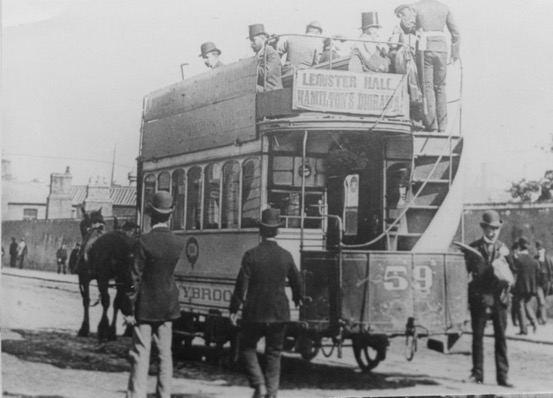
Something of a rarity for a Dublin horse tram photograph, one capturing a conductor. The scene is of Horsecar No 59 on the Donnybrook route — photo undated, but probably taken in the late 1880s or early 1890s judging by the tall bowlers and top hats, and the advertisement for Leinster Hall, which opened in 1886. Photo courtesy of Jim Kilroy, tram archivist at the National Transport Museum (see link). 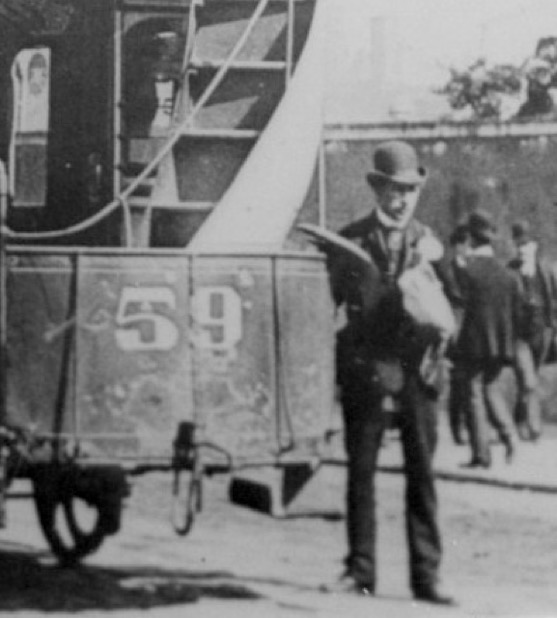
An enlargement of the above photograph showing the conductor, who is in informal attire, but clearly wearing a large oval licence, which is attached to his cash-bag strap.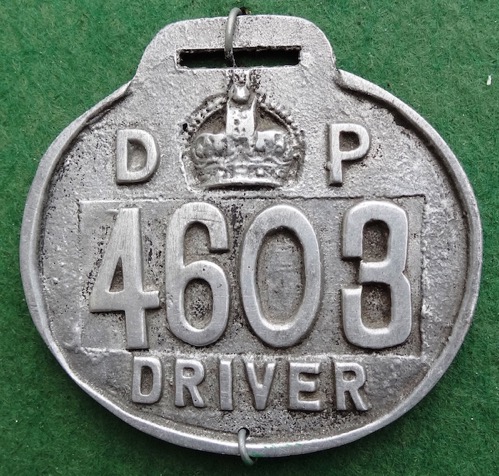
Dublin Police driver's licence, No 4603 — nickel or alloy. This is possibly the pattern worn by Dublin horse tram drivers, though photographic confirmation is unfortunately elusive. Photo courtesy of Jim Kilroy, tram archivist at the National Transport Museum.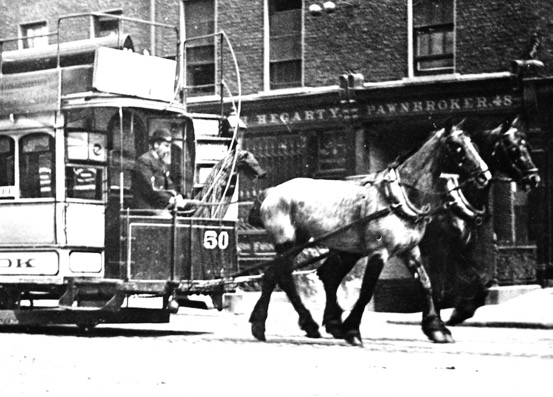
The driver of Horsecar No 50, in informal attire with bowler hat, urges his charges along Lower Baggot Street with a Donnybrook service — photo undated, but thought to have been taken in the early 1890s. Photo courtesy of the National Tramway Museum.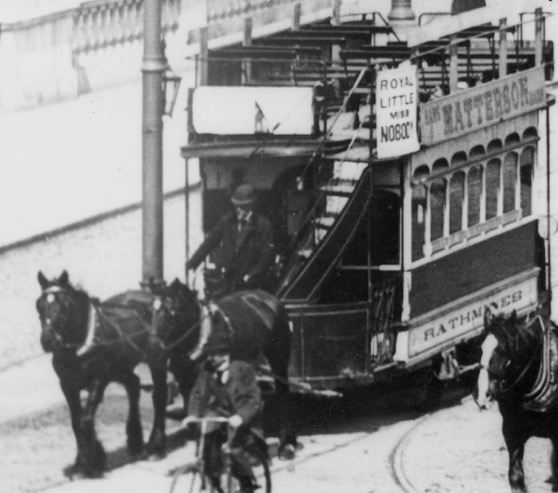
The driver of an unknown horsecar negotiates a busy O'Connell Bridge — photo undated, but certainly taken after 1898, when the play (Little Miss Nobody) was written, but before August 1899 when the Rathmines route was electrified. Photo courtesy of Jim Kilroy, tram archivist at the National Transport Museum.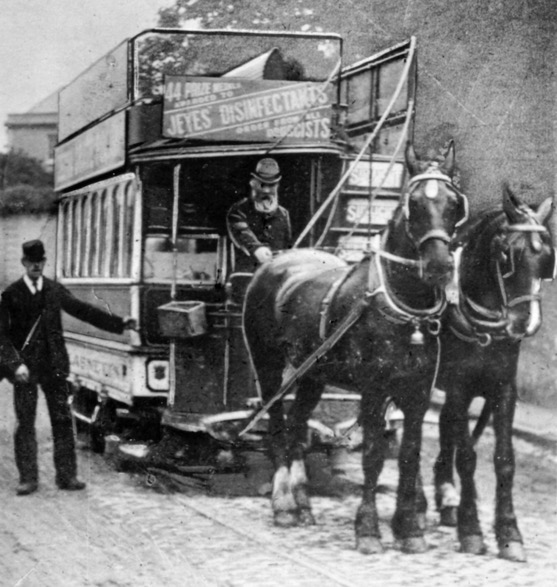
A photograph that appears to have been subjected to some fairly heavy-handed modification, but one which shows a conductor in a uniform, shirt and tie, and kepi-style cap — photo undated, but certainly taken between the introduction of uniforms (1896/7) and the electrification of the Glasnevin route (December 1899). Photo courtesy of the Tramways and Light Railway Society, with thanks to David Voice.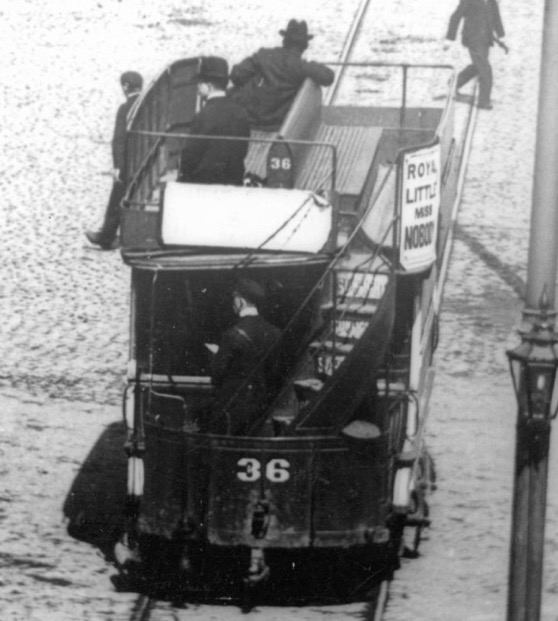
A DUTCo conductor, in uniform and oblivious to the presence of the camera, goes about his job on the rear platform of Horsecar No 36. Although undated, the shot must have been taken after 1898, as the same play is on at the Theatre Royal (see decency panel advertisement), as seen in an earlier photograph. Photo courtesy of Jim Kilroy, tram archivist at the National Transport Museum.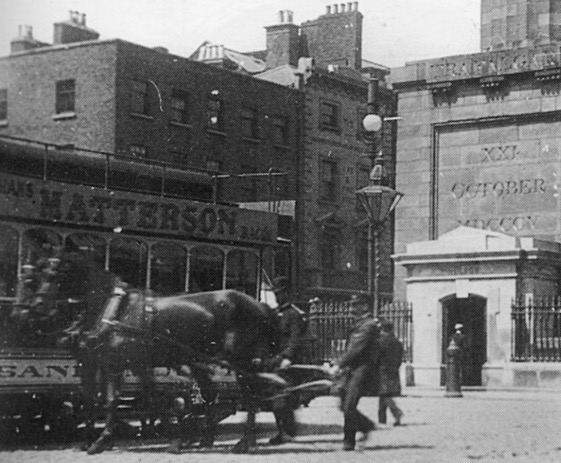
A very rare shot, for any horse tramway, let alone the DUTCo, of a crew transferring their horses from one end of the vehicle to the other. The conductor (on the right) is wearing a uniform with kepi-style cap and cap badge, whereas the driver (to the left and rear of the far horse) is wearing informal attire with the ubiquitous driver's bowler hat. The photo is undated, but must have been taken between the introduction of uniforms (1896/7) and electrification of the Sandymount route (1901). Photo courtesy of the Tramways and Light Railway Society, with thanks to David Voice
Motormen and conductors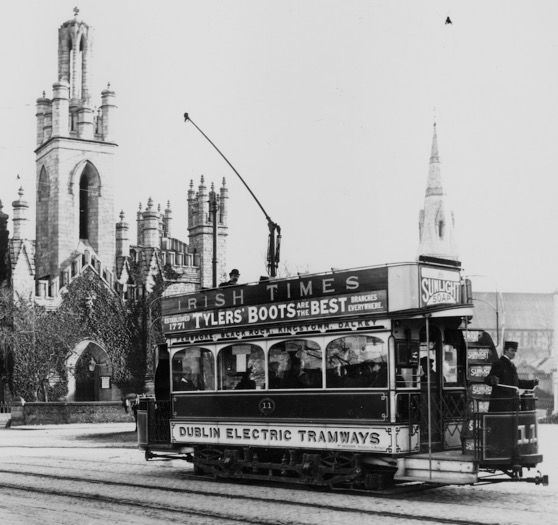
A fine study of a motorman at the controls of a pristine-looking Tramcar No 11, an ex-DSDTCo vehicle, still bearing the title 'Dublin Electric Tramways', but with the DUTCo device and manager's name, so probably taken in 1897. The vehicle is passing Monkstown church. Photo courtesy of Jim Kilroy, tram archivist at the National Transport Museum.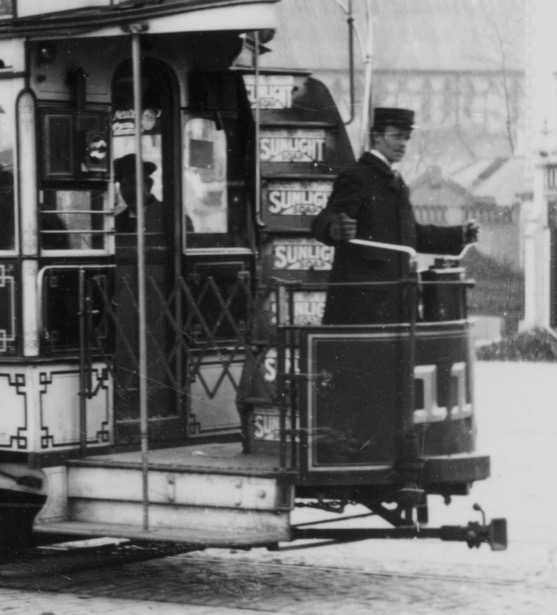
An enlargement of the above photograph showing the conductor, in greatcoat and kepi-style cap.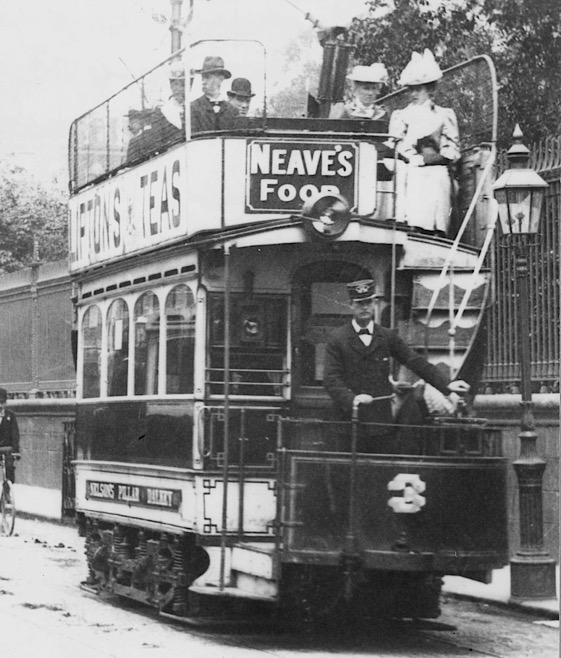
A DUTCo motorman at the controls of Tramcar No 3, a former Dublin Southern District Tramways Company vehicle, on the Dalkey line — photo undated, but given the good condition of the tram, albeit now with advertisements and a route board (on the rocker panel) including Nelson Pillar, probably taken in 1898. Photo courtesy of Jim Kilroy, tram archivist at the National Transport Museum.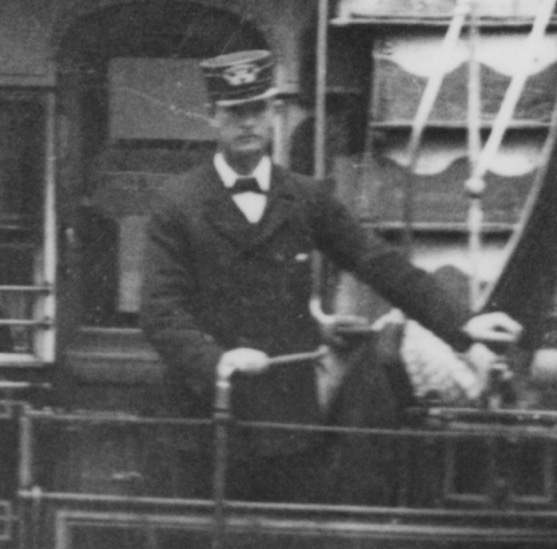
An enlargement of the above photograph showing the motorman. The uniform is very similar in overall style to that issued by the DSDTCo, suggesting that the DUTCo copied it; the one clear difference between the DUTCo jackets and those of the DSDTCo is the absence of collar insignia. The cap badge seen in this photograph is a slightly different shape to those seen in most others, raising the possibility that the subject may actually have been an inspector.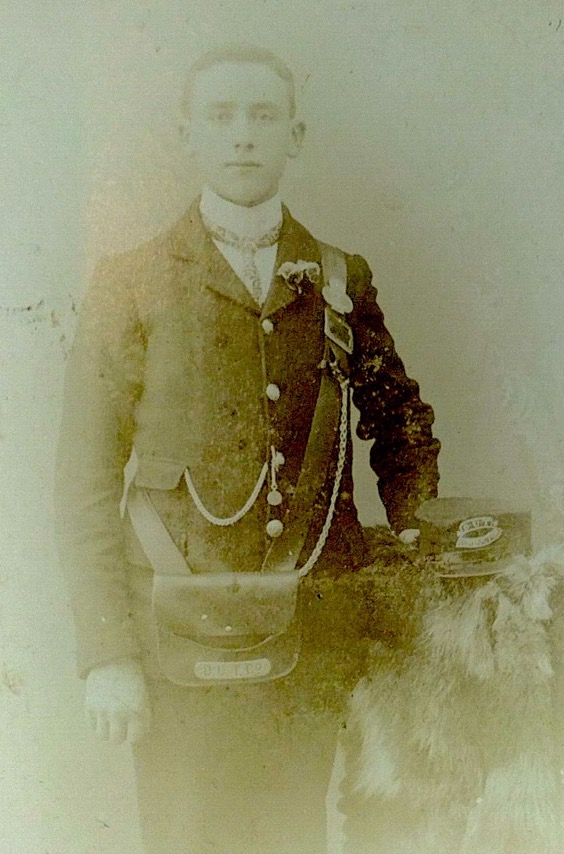
A rare studio portrait of a DUTCo electric tram conductor — photo undated, but probably taken between 1897 and 1900. Whilst the jacket bears no insignia, the subject's cash bag bears the name of the owning company ('D.U.T. Co'), and the cash-bag strap bears a shamrock-shaped licence badge issued by Dublin Police. The photo was taken in the studios of T A Atkinson, 8 Grove Road, Harold's Cross, Grand Canal, Dublin. Source unknown.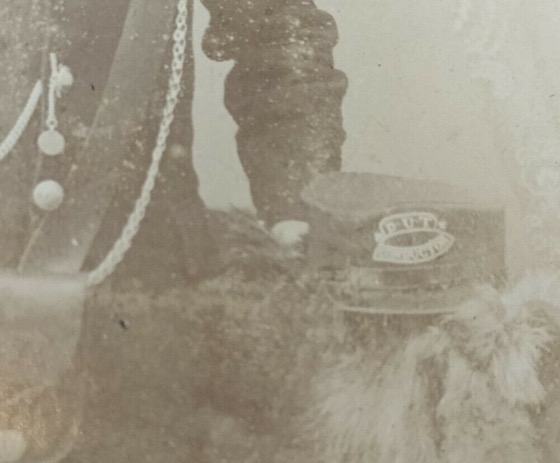
An enlargement of the above photograph showing the kepi-style cap. The cap badge, which is embroidered, comprises two curved borders; the top border bears system initials ('D.U.T') and the bottom border the grade ('CONDUCTOR').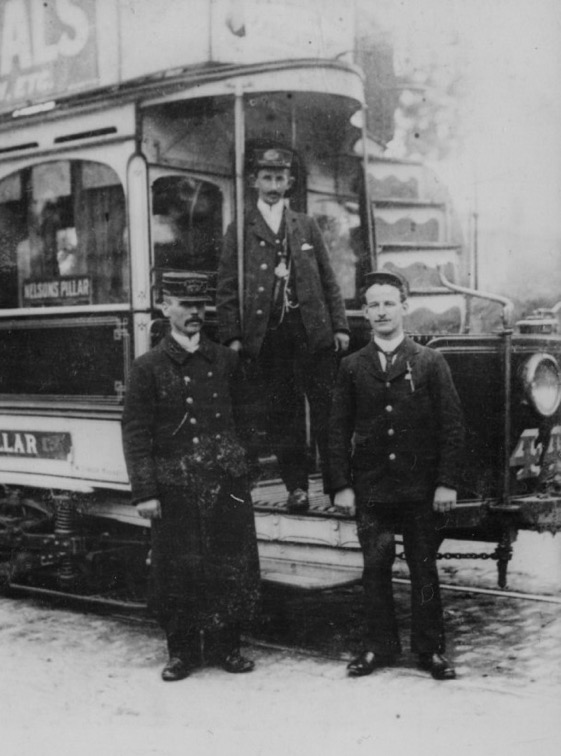
Another fairly early photograph, probably taken before the turn of the century, this time of Tramcar No 44. The two men in lapel jackets are likely to be a motorman (on the platform) and a conductor, though the latter's lack of a cash-bag suggests that he may be another motorman. The man on the left in the long, double-breasted jacket is probably an inspector. Although broadly similar in shape, his cap badge differs from those used on tramcar crew caps. Photo courtesy of Jim Kilroy, tram archivist at the National Transport Museum.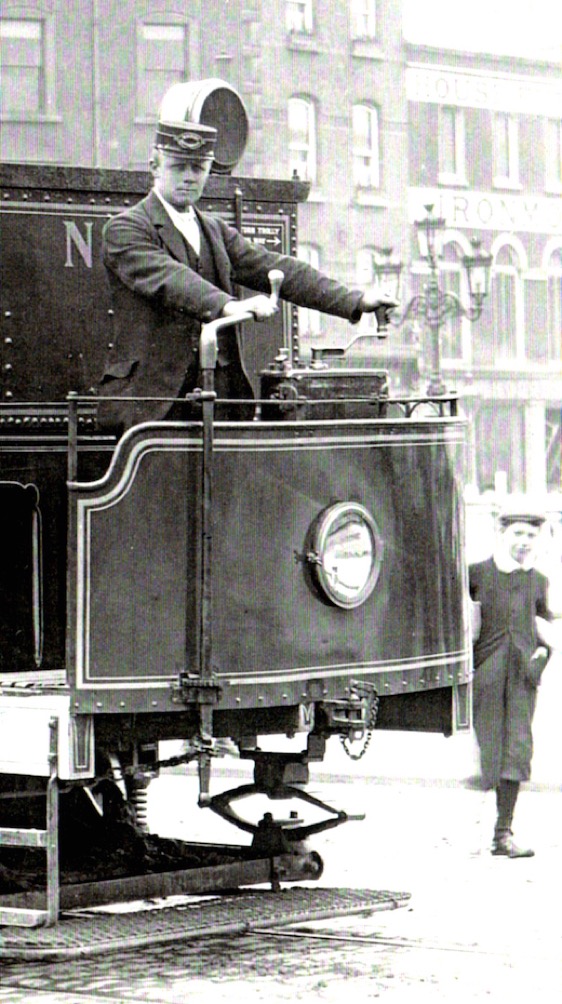
A DUTCo motorman at the controls of a water car on O'Connell Bridge — photo undated, but probably early-to-mid Edwardian. The form of the cap badge is seen much more clearly in this image, though it is still not possible to say whether the DUTCo used 'DRIVER' or 'MOTORMAN' on these grade badges. Photo courtesy of Jim Kilroy, tram archivist at the National Transport Museum.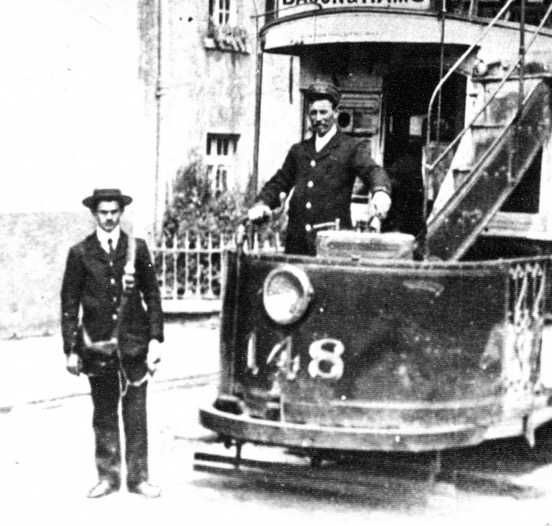
Although not of particularly good quality, this photo is included as the names of the conductor (Pat Magurie) and motorman (Mr Boggan) have survived — date unknown, but probably mid Edwardian. The scene, taken at Rathfarnham, includes a rather battered No 148, with Conductor Magurie in a straw boater, so it was presumably summer. Photo courtesy of Jim Kilroy, tram archivist at the National Transport Museum.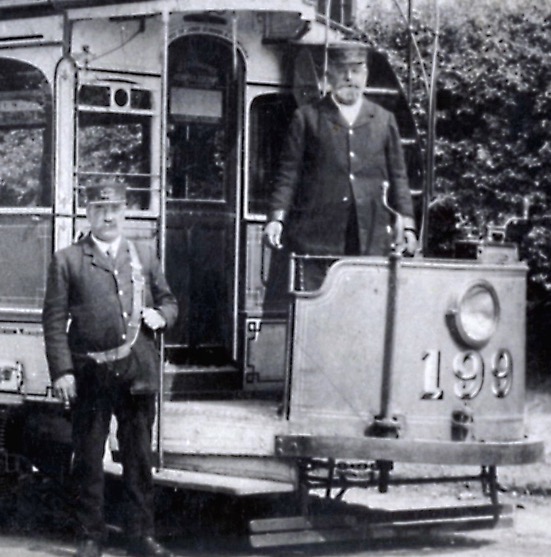
The crew of Tramcar No 199 pose with their charge at the terminus at Whitehall — photo undated, but thought to have been taken between 1910 and the Great War. Photo courtesy of Jim Kilroy, tram archivist at the National Transport Museum.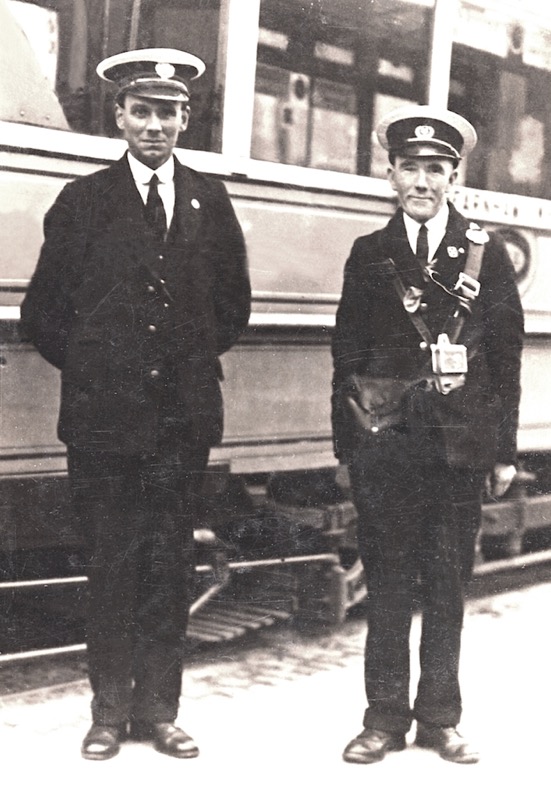
Conductor John Lonergan (right) along with an unidentified motorman (left) — photo undated, but probably taken in the 1930s (John was born around 1880 in County Tipperary and died in the late 1940s). The caps had by this time (the 1930s) been changed to a more modern tensioned crown type, and the old cloth cap badge to a smart gilt and blue enamel pattern (see below). Attached to the top of Mr Lonergan's cash-bag strap is a shamrock-shaped Dublin Police licence (see below for an example). Photo courtesy of Jim Kilroy, tram archivist at the National Transport Museum.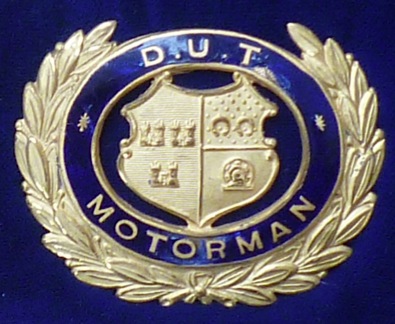
DUTCo 'Motorman' cap badge — gilt and blue enamel. This was worn from the 1920s through to 1945. Author's Collection.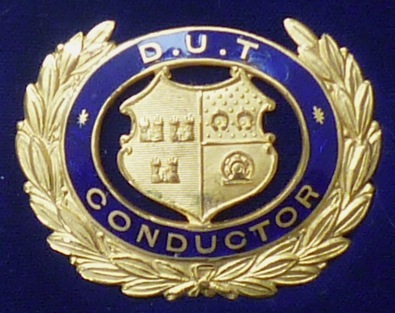
DUTCo 'Conductor' cap badge — gilt and blue enamel. This was worn from the 1920s through to 1945. Author's Collection.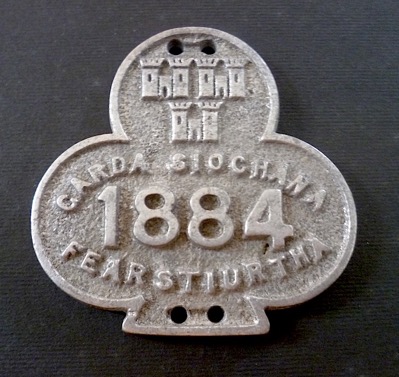
Dublin Police-issued conductor's licence No 1884 — nickel. The text reads: 'GARDA SÍOCHÁNA' and 'FEARSTIURTHA', which means "Guardian of the peace" (effectively the police) and "Conductor". These were worn by all tramway conductors, and were probably introduced shortly after Irish independence, so in the early 1920s. Author's Collection.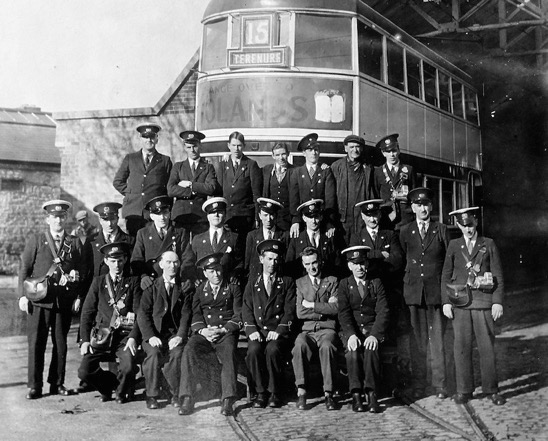
A nice staff shot taken on a summer's day at Terenure depot in 1932. Conductors and motormen are wearing the usual single-breasted jackets without collar insignia, whereas the senior staff, probably inspectors (seated in the centre) are wearing double-breasted jackets with collar insignia and embellishments to both the collars and the sleeves. Photo courtesy of Jim Kilroy, tram archivist at the National Transport Museum.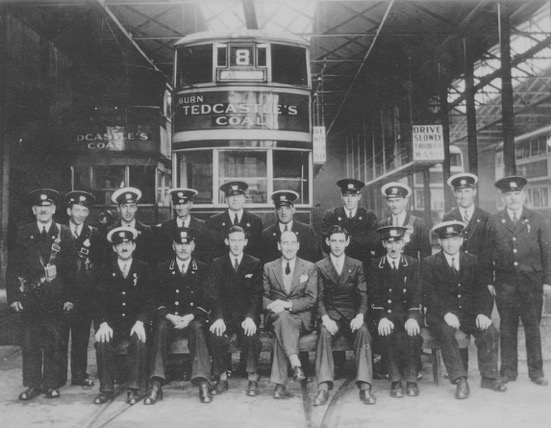
Another depot shot, this time at Blackrock depot, with conductors, motormen and two inspectors — photo undated, but probably taken in the early 1930s. It was definitely taken before 1936, as the man on the extreme right (Joseph Lawlor) retired that year; he was born in Ballywilliam in County Wexford in 1872, and when the photo was taken, he would have been a senior motorman. Thanks to his great grandson Mark Black for this information. Photo courtesy of Jim Kilroy, tram archivist at the National Transport Museum.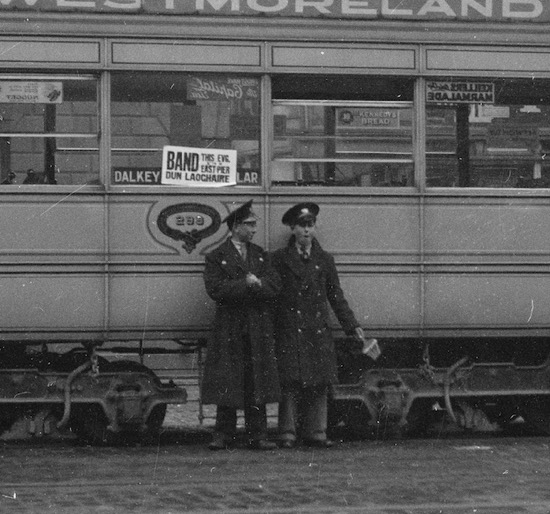
The crew of Tramcar No 298 captured outside the GPO in O'Connell St on what is believed to have been the 1st June 1936. The wide tensioned crown of the peaked cap is clearly seen, as are the long, double-breasted greatcoats. Photo by Dr H Nicol, courtesy of the National Tramway Museum. 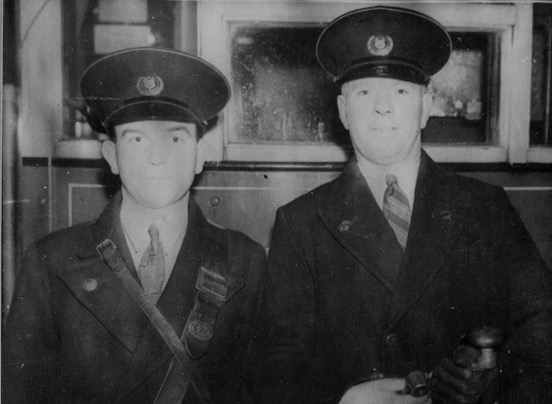
Conductor Nestor and Motorman McDonald standing in front of Tramcar No 137, which was scrapped at Dartry depot in 1939 — photo undated, but probably taken in the mid-to-late 1930s. The shape of the cap badge is easily made out, as is the piping around the crown. Conductor Nestor is wearing a new oval PSV badge on his cash-bag strap, rather than the shamrock-shaped pattern. Photo courtesy of Jim Kilroy, tram archivist at the National Transport Museum.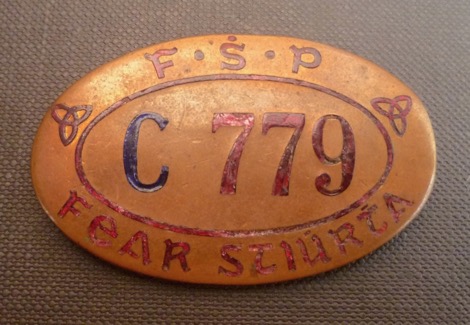
Dublin conductor's PSV badge No 2626. These badges were introduced some time in the mid-1930s. 'F S P' stands for 'Feithicil Seirbhíse Puiblí', which translates as Public Service Vehicle in English. Author's Collection; translation courtesy of Jim Kilroy.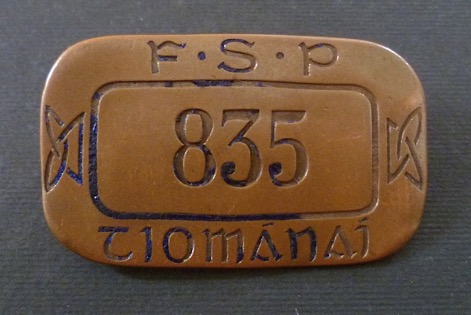
Dublin driver's PSV badge No 835. 'Tiomanai' translates as 'Driver'. These badges were introduced some time in the mid-1930s, and motormen were purportedly required to wear them, though I have only seen a single photo where one is being worn. Author's Collection.
A conductor, a motorman, and an unknown individual pose for the camera — photo undated, but probably taken in the early 1940s. Photo courtesy of Jim Kilroy, tram archivist at the National Transport Museum.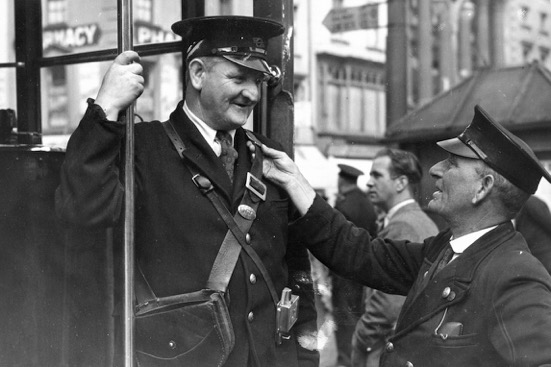
A Dublin tram conductor in Córas Iompair Éireann days, so taken some time between January 1946 and closure of the system in 1949. The individual on the right is possibly an inspector or timekeeper. Photo courtesy of Jim Kilroy, tram archivist at the National Transport Museum.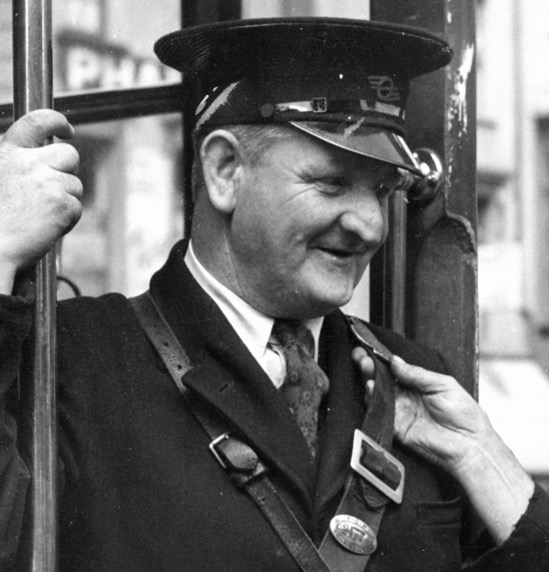
An enlargement of the above photograph showing details of the conductor's uniform, including the oval conductor's licence (on his cash-bag strap) and the new CIE cap badge. The cap badge logo is actually based on a design introduced by the DUTCo around 1941, but one which is thought not to have been applied to uniforms. The inspector's thumb is touching the older, shamrock-shaped Dublin Police licence. How this related to the oval PSV badge is unclear, though in all likelihood the oval pattern was a replacement for the earlier shamrock-shaped pattern.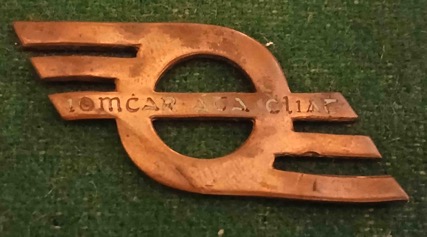
CIE cap badge — copper-coloured brass with green enamel inlay. This is believed to have been the first pattern of CIE cap badge issued, though it was fairly quickly superseded by a plain brass version lacking the lettering. Photo courtesy of Donncha Cronin.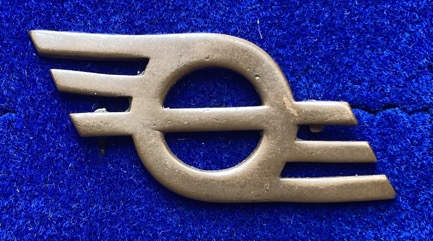
CIE cap badge — brass. Author's Collection.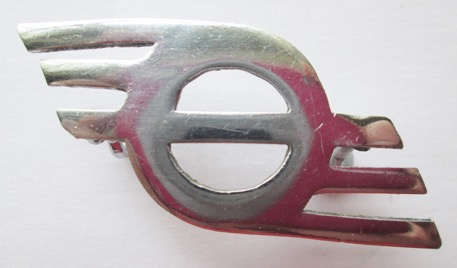
CIE cap badge — chrome. It is likely that the switch to chrome insignia did not occur until after the demise of the tramway, though evidence either supporting or refuting this is currently lacking. Photo courtesy of the Stephen Howarth Collection.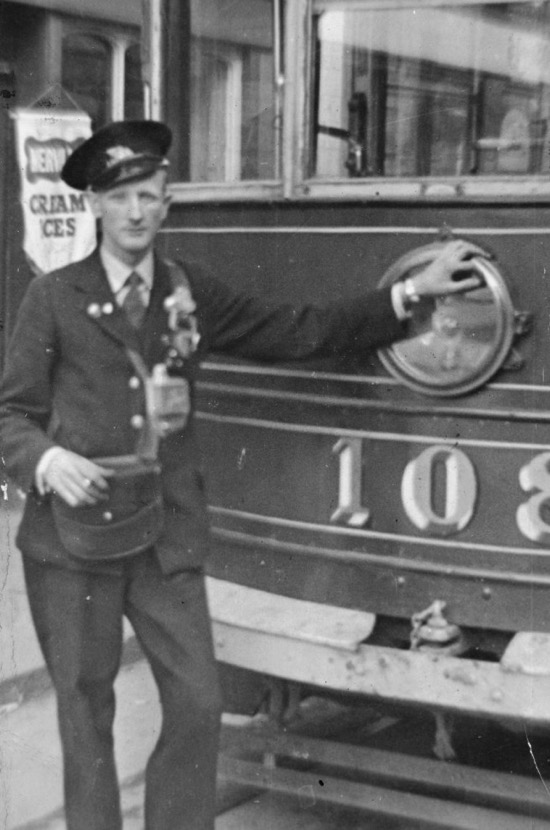
Although out of focus, this shot of a conductor next to Tramcar No 108 clearly shows the shamrock shape of the police licence badge — photo undated, but certainly taken in CIE days. Photo courtesy of Jim Kilroy, tram archivist at the National Transport Museum.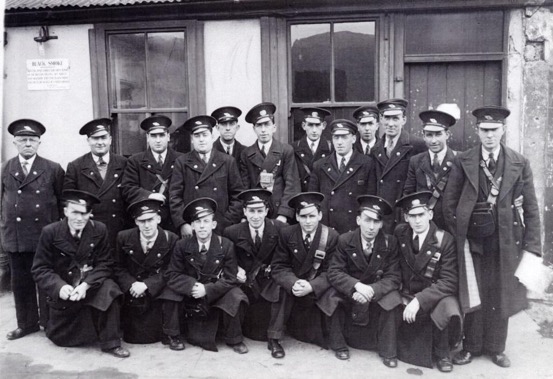
A group of conductors and inspectors captured for posterity at an unknown depot, some wearing DUTCo cap badges and others the newer CIE ones, so definitely taken after the creation of the latter in 1945. Photo courtesy of Jim Kilroy, tram archivist at the National Transport Museum.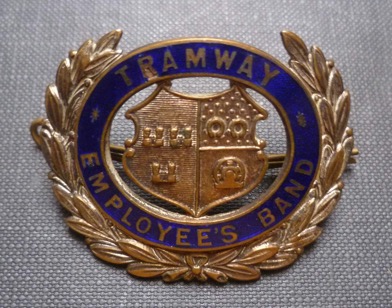
DUTCo Employee's Band cap badge — gilt and blue enamel. Given that the pattern of this badge is identical to that used by tramcar staff from the 1920s onwards, it is almost certain that this badge stems from that period. Author's Collection.
Senior staff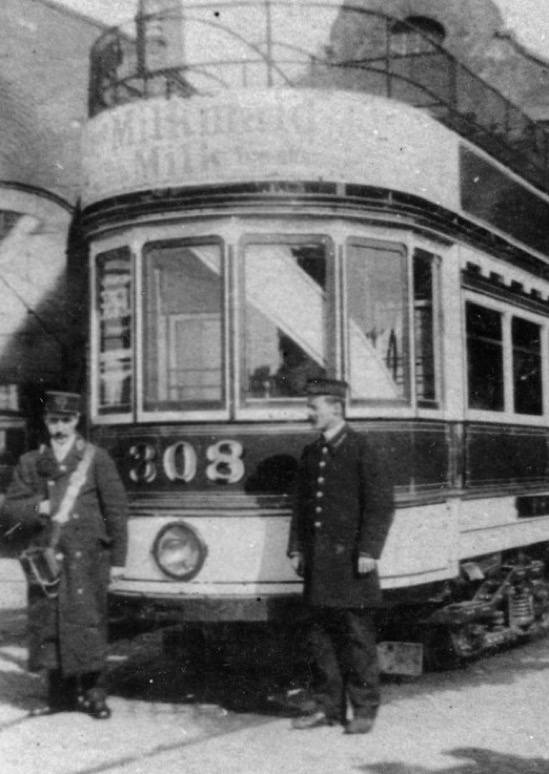
A rare shot of a DUTCo inspector, in short single-breasted overcoat with collar insignia, and a kepi-style cap — photo taken at Clontarf DUTCo depot some time before 1904 (the tramcar, which belonged to the Clontarf and Hill of Howth Tramroad Company, lacks the Tidswell lifeguards that were fitted in 1904). Photo courtesy of Jim Kilroy, tram archivist at the National Transport Museum
.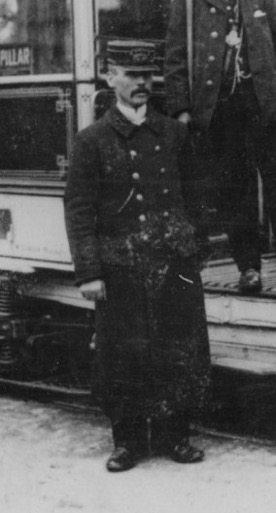
An enlargement of the photograph of Tramcar No 48 above showing an individual who is probably an inspector. His long greatcoat carries embroidered insignia on the collar. His embroidered cap badge, which is broadly similar to those worn by tramcar crews, has marked differences, though exactly what information it bore remains, in the absence of better photographic evidence, unclear.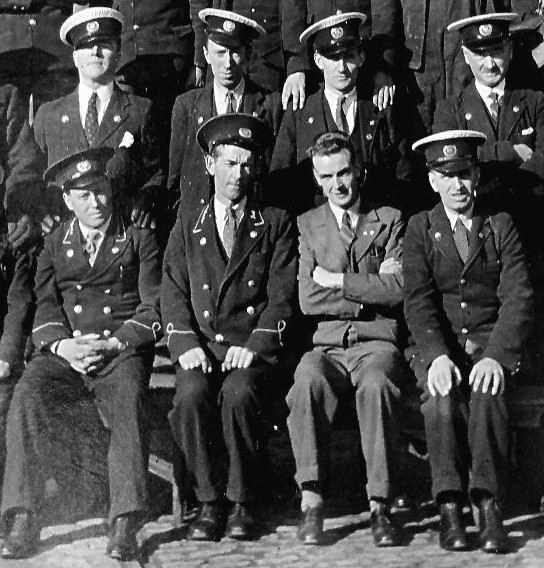
An enlargement of the 1932 Terenure depot shot above, showing two inspectors (1st and 2nd left, seated). Both men are wearing double-breasted jackets with embroidered collar insignia — almost certainly their grade — and embellishments to both the collars and the jacket sleeves. The individual on the right of the front row is Dave Donoghue.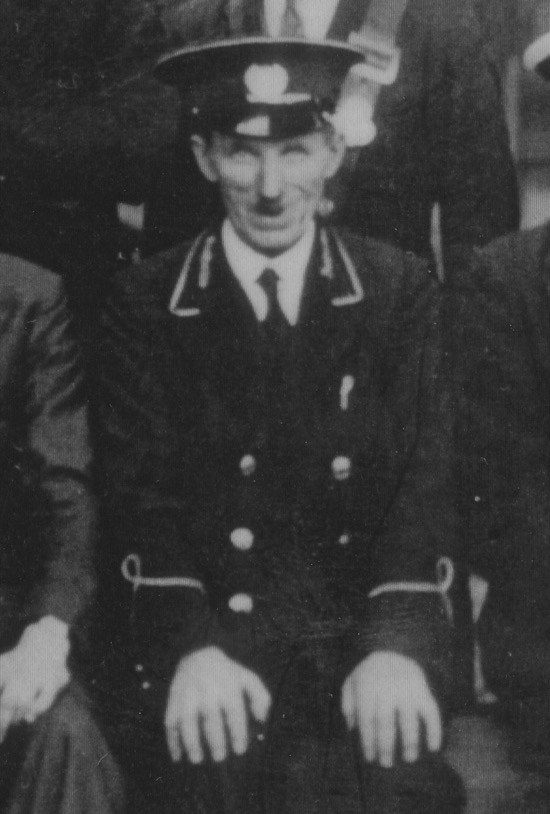
An enlargement of the Dalkey depot staff photograph above, showing one of the inspectors in his double-breasted uniform jacket.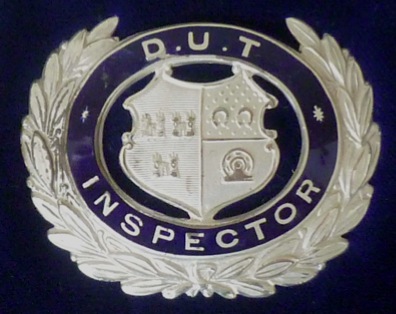
DUTCo 'INSPECTOR' cap badge — silver gilt. This was worn from the 1920s through to 1945. Author's Collection.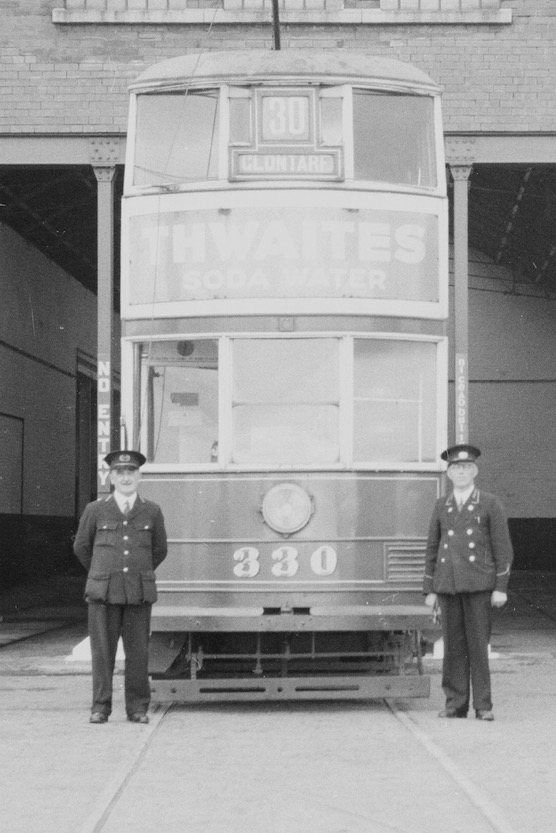
Two individuals in jackets which differ markedly from those worn by tramcar crews, and who are therefore, probably of a more senior grade, i.e., inspectors or chief inspectors — photo undated, but probably taken in the late 1930s. Both jackets bear collar insignia, something notably absent from tramcar crew uniforms. Photo by W A Camwell, courtesy of the National Tramway Museum. 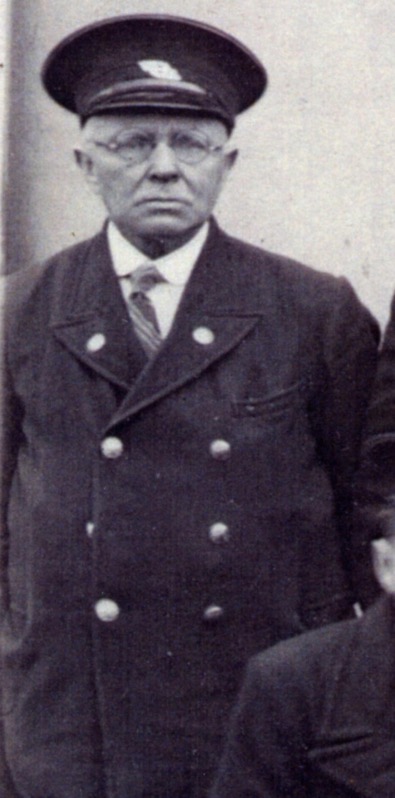
An enlargement of the staff photograph shown above taken in CIE days. The individual depicted is wearing a double-breasted jacket without insignia, and may be an inspector, though this is by no means certain.